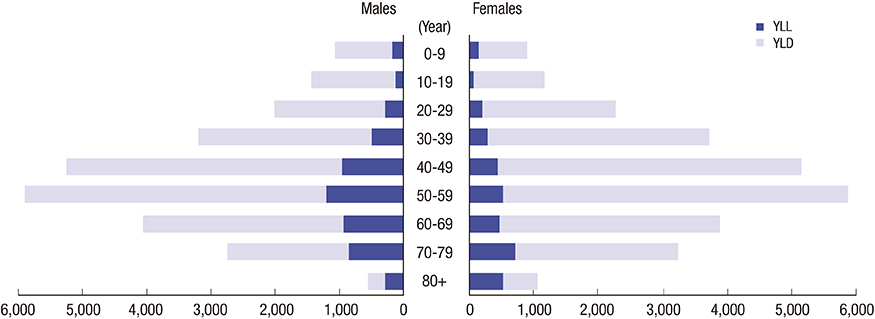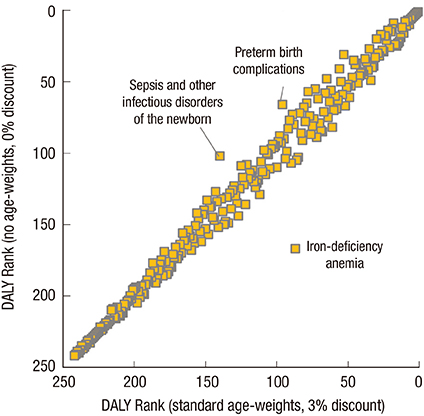Disability-adjusted Life Years for 313 Diseases and Injuries: the 2012 Korean Burden of Disease Study
- Affiliations
-
- 1Department of Public Health, Graduate School, Korea University, Seoul, Korea.
- 2Department of Preventive Medicine, School of Medicine, Kyung Hee University, Seoul, Korea.
- 3Department of Nursing, Pyeongtaek University, Pyeongtaek, Korea.
- 4Department of Preventive Medicine, College of Medicine, Korea University, Seoul, Korea. yoonsj02@korea.ac.kr
- 5Department of Preventive Medicine, University of Ulsan College of Medicine, Seoul, Korea.
- 6Department of Preventive Medicine, School of Medicine, Ewha Womans University, Seoul, Korea.
- 7Department of Social and Preventive Medicine, Inha University School of Medicine, Incheon, Korea.
- KMID: 2360665
- DOI: http://doi.org/10.3346/jkms.2016.31.S2.S146
Abstract
- This study is part of a 5-year research project on the national burden of diseases, injuries, and risk factors in Korea. Using disability-adjusted life years (DALYs), a metric introduced by the 1990 Global Burden of Disease (GBD) project, we performed a comprehensive and detailed assessment of the magnitude and distribution of both fatal and non-fatal health problems in the Korean population. The concept and general approach were consistent with the original GBD study, with some methodological modifications to make the study more suitable for Korea. We computed DALYs for 313 causes in both sexes and nine age groups using the entire population's medical records and newly generated Korean disability weights. In 2012, the dominant disease burden was non-communicable diseases, which accounted for 85.21% of total DALYs, while injuries accounted for 7.77% and communicable, maternal, neonatal, and nutritional disorders for 7.02%. Of the total DALYs, 88.67% were from years lived with disability and 11.32% were from years of life lost due to premature mortality. Diabetes mellitus was the leading cause of DALYs, followed by low back pain, chronic obstructive pulmonary disease, ischemic heart disease, ischemic stroke, cirrhosis of the liver, falls, osteoarthritis, motorized vehicle with three or more wheels, and self-harm. The results reported here identify key health challenges and opportunities for future health interventions and policy changes, and provide information that will help assess the major public health issues in Korea, a nation faced with one of the world's most rapidly ageing populations.
Keyword
MeSH Terms
Figure
Cited by 10 articles
-
The Korean National Burden of Disease Study: from Evidence to Policy
Seok-Jun Yoon, Dun-Sol Go, Hyesook Park, Min-Woo Jo, In-Hwan Oh, Young-Eun Kim
J Korean Med Sci. 2019;34(Suppl 1):. doi: 10.3346/jkms.2019.34.e89.Years of Life Lost due to Premature Death in People with Disabilities in Korea: the Korean National Burden of Disease Study Framework
Young-Eun Kim, Ye-Rin Lee, Seok-Jun Yoon, Young-Ae Kim, In-Hwan Oh
J Korean Med Sci. 2019;34(2):. doi: 10.3346/jkms.2019.34.e22.Trends and Patterns of Burden of Disease and Injuries in Korea Using Disability-Adjusted Life Years
Young-Eun Kim, Hyesook Park, Min-Woo Jo, In-Hwan Oh, Dun-Sol Go, Jaehun Jung, Seok-Jun Yoon
J Korean Med Sci. 2019;34(Suppl 1):. doi: 10.3346/jkms.2019.34.e75.Projection of the Years of Life Lost, Years Lived with Disability, and Disability-Adjusted Life Years in Korea for 2030
Bomi Park, Bohyun Park, Hyejin Han, Eun Jung Choi, Nam-eun Kim, Yoonhee Shin, Hyesook Park
J Korean Med Sci. 2019;34(Suppl 1):. doi: 10.3346/jkms.2019.34.e92.Estimating Lifetime Duration of Diabetes by Age and Gender in the Korean Population Using a Markov Model
Seung Woo Cho, Seon Ha Kim, Young-Eun Kim, Seok-Jun Yoon, Min-Woo Jo
J Korean Med Sci. 2019;34(Suppl 1):. doi: 10.3346/jkms.2019.34.e74.Disease-Specific Mortality and Prevalence Trends in Korea, 2002–2015
Yoonhee Shin, Bomi Park, Hye Ah Lee, Bohyun Park, Hyejin Han, Eun Jeong Choi, Nam-eun Kim, Hyesook Park
J Korean Med Sci. 2020;35(4):. doi: 10.3346/jkms.2020.35.e27.Evaluation of the prevalence of musculoskeletal symptoms, presumptive diagnosis, medical care use, and sick leave among female school meal service workers
Young Hoon Moon, Young Joon Yang, Sang Yoon Do, Jae Yoon Kim, Chul Gab Lee, Hong Jae Chae, Soo Hyeon Kim, Han Soo Song
Ann Occup Environ Med. 2019;31(1):. doi: 10.1186/s40557-019-0281-0.Outcomes of the support services for the establishment of regional level 1 trauma centers
Jong-Min Park
J Korean Med Assoc. 2016;59(12):923-930. doi: 10.5124/jkma.2016.59.12.923.Hospital-Based Korean Diabetes Prevention Study: A Prospective, Multi-Center, Randomized, Open-Label Controlled Study
Sang Youl Rhee, Suk Chon, Kyu Jeung Ahn, Jeong-Taek Woo,
Diabetes Metab J. 2019;43(1):49-58. doi: 10.4093/dmj.2018.0033.Joinpoint Regression About Injury Mortality and Hospitalization in Korea
Hyun Jin Park, Ui Jeong Kim, Won kyung Lee, Bohyun Park, Yoonhee Shin, Seonhwa Lee, Eun Jeong Choi, Nam-eun Kim, Ju Ok Park, Hyesook Park
J Korean Med Sci. 2021;37(3):e10. doi: 10.3346/jkms.2022.37.e10.
Reference
-
1. Omran AR. The epidemiologic transition. A theory of the epidemiology of population change. Milbank Mem Fund Q. 1971; 49:509–538.2. Murray CJ. Summary Measures of Population Health: Concepts, Ethics, Measurement and Applications. Geneva: World Health Organization;2002.3. Murray CJ, Lopez AD. The Global Burden of Disease: a Comprehensive Assessment of Mortality and Disability from Diseases, Injuries and Risk Factors in 1990 and Projected to 2020. Cambridge, MA: Harvard University Press;1996.4. Lopez AD, Mathers CD, Ezzati M, Jamison DT, Murray CJ. Global Burden of Disease and Risk Factors. Washington, D.C.: The International Bank for Reconstruction and Development/The World Bank;2006.5. Mathers CD, Vos ET, Stevenson CE, Begg SJ. The burden of disease and injury in Australia. Bull World Health Organ. 2001; 79:1076–1084.6. Murray CJ, Vos T, Lozano R, Naghavi M, Flaxman AD, Michaud C, Ezzati M, Shibuya K, Salomon JA, Abdalla S, et al. Disability-adjusted life years (DALYs) for 291 diseases and injuries in 21 regions, 1990-2010: a systematic analysis for the global burden of disease study 2010. Lancet. 2012; 380:2197–2223.7. Melse JM, Essink-Bot ML, Kramers PG, Hoeymans N; Dutch Burden of Disease Group. A national burden of disease calculation: Dutch disability-adjusted life-years. Am J Public Health. 2000; 90:1241–1247.8. Murray CJ, Lopez AD. Global Comparative Assessments in the Health Sector: Disease Burden, Expenditures, and Intervention Packages. Geneva: World Health Organization;1994.9. Murray CJ, Lopez AD. Measuring the global burden of disease. N Engl J Med. 2013; 369:448–457.10. Statistics Korea. Korean statistical information service [Internet]. accessed on 11 November 2015. Available at http://kosis.kr/.11. Organisation for Economic Co-operation and Development. OECD health statistics 2015: how dose health spending in Korea compare? [Internet]. accessed on 11 November 2015. Available at http://www.oecd.org/els/health-systems/Country-Note-KOREA-OECD-Health-Statistics-2015.pdf.12. Begg SJ, Vos T, Barker B, Stanley L, Lopez AD. Burden of disease and injury in Australia in the new millennium: measuring health loss from diseases, injuries and risk factors. Med J Aust. 2008; 188:36–40.13. Mathers CD, Vos T, Lopez AD, Salomon J, Ezzati M. National Burden of Disease Studies: a Practical Guide; Edition 2.0. Geneva: World Health Organization;2001.14. Kim SH, Lee HJ, Ock M, Go DS, Kim HJ, Lee JY, Jo MW. Disability-Adjusted Life Years for Maternal, Neonatal, and Nutritional Disorders in Korea. J Korean Med Sci. 2016; 31:Suppl 2. S184–S190.15. Statistics Korea. Korean statistical information service: life table [Internet]. accessed on 17 November 2015. Available at http://kosis.kr/statisticsList/statisticsList_01List.jsp?vwcd=MT_ZTITLE&parentId=A#SubCont.16. World Health Organization. WHO Methods and Data Sources for Global Burden of Disease Estimates 2000-2011. Geneva: World Health Organization;2013.17. Murray CJ, Ezzati M, Flaxman AD, Lim S, Lozano R, Michaud C, Naghavi M, Salomon JA, Shibuya K, Vos T, et al. GBD 2010: design, definitions, and metrics. Lancet. 2012; 380:2063–2066.18. Ock M, Lee JY, Oh IH, Park H, Yoon SJ, Jo MW. Disability Weights Measurement for 228 Causes of Disease in the Korean Burden of Disease Study 2012. J Korean Med Sci. 2016; 31:Suppl 2. S129–S138.19. Lee YR, Kim YA, Park SY, Oh CM, Kim YE, Oh IH. Application of a Modified Garbage Code Algorithm to Estimate Cause-Specific Mortality and Years of Life Lost in Korea. J Korean Med Sci. 2016; 31:Suppl 2. S121–S128.20. National Health Insurance Services (KR). Major statistics on national health insurance services: 2012 [Internet]. accessed on 11 November 2015. Available at http://www.nhis.or.kr.21. National Cancer Center (KR). Annual Report of Cancer Statistics in Korea in 2012. Ilsan: National Cancer Center;2014.22. Lee WK, Lim D, Park H. Disability-Adjusted Life Years (DALYs) for Injuries Using Death Certificates and Hospital Discharge Survey by the Korean Burden of Disease Study 2012. J Korean Med Sci. 2016; 31:Suppl 2. S200–S207.23. Barendregt JJ, Van Oortmarssen GJ, Vos T, Murray CJ. A generic model for the assessment of disease epidemiology: the computational basis of DisMod II. Popul Health Metr. 2003; 1:4.24. National Health Insurance Service (KR). Health Insurance Review & Assessment Service (KR). Health Insurance Statistical Yearbook 2012. National Health Insurance Service; Health Insurance Review & Assessment Service;2013.25. World Health Organization. Metrics: disability-adjusted life year (DALY) [Internet]. accessed on 30 November 2015. Available at http://www.who.int/healthinfo/global_burden_disease/metrics_daly/en/.26. Ezzati M, Riboli E. Can noncommunicable diseases be prevented? Lessons from studies of populations and individuals. Science. 2012; 337:1482–1487.27. Kim EJ, Yoon SJ, Jo MW, Kim HJ. Measuring the burden of chronic diseases in Korea in 2007. Public Health. 2013; 127:806–813.28. Yoon SJ, Bae SC, Lee SI, Chang H, Jo HS, Sung JH, Park JH, Lee JY, Shin Y. Measuring the burden of disease in Korea. J Korean Med Sci. 2007; 22:518–523.29. Yoon J, Seo H, Oh IH, Yoon SJ. The Non-Communicable Disease Burden in Korea: Findings from the 2012 Korean Burden of Disease Study. J Korean Med Sci. 2016; 31:Suppl 2. S158–S167.30. Vos T, Barber RM, Bell B, Bertozzi-Villa A, Biryukov S, Bolliger I, Charlson F, Davis A, Degenhardt L, Dicker D. Global, regional, and national incidence, prevalence, and years lived with disability for 301 acute and chronic diseases and injuries in 188 countries, 1990-2013: a systematic analysis for the global burden of disease study 2013. Lancet. 2015; 386:743–800.31. March L, Smith EU, Hoy DG, Cross MJ, Sanchez-Riera L, Blyth F, Buchbinder R, Vos T, Woolf AD. Burden of disability due to musculoskeletal (MSK) disorders. Best Pract Res Clin Rheumatol. 2014; 28:353–366.32. Hoy D, Geere JA, Davatchi F, Meggitt B, Barrero LH. A time for action: opportunities for preventing the growing burden and disability from musculoskeletal conditions in low- and middle-income countries. Best Pract Res Clin Rheumatol. 2014; 28:377–393.33. Lim D, Lee WK, Park H. Disability-adjusted Life Years (DALYs) for Mental and Substance Use Disorders in the Korean Burden of Disease Study 2012. J Korean Med Sci. 2016; 31:Suppl 2. S191–S199.34. Yoon J, Yoon SJ. Quantifying Burden of Disease to Measure Population Health in Korea. J Korean Med Sci. 2016; 31:Suppl 2. S101–S107.
- Full Text Links
- Actions
-
Cited
- CITED
-
- Close
- Share
- Similar articles
-
- Disability-Adjusted Life Years (DALYs) for Injuries Using Death Certificates and Hospital Discharge Survey by the Korean Burden of Disease Study 2012
- Disability-adjusted Life Years (DALYs) for Mental and Substance Use Disorders in the Korean Burden of Disease Study 2012
- Review of Issues for Disability Weight Studies
- Trends and Patterns of Burden of Disease and Injuries in Korea Using Disability-Adjusted Life Years
- The burden of disease in Korea






